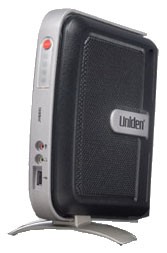By Rob Knies, Managing Editor, Microsoft Research
Xuedong Huang has a mantra:
Act fast, ponder less, and learn.
Spotlight: On-demand video
Those precepts are not common in research circles, where careful deliberation is generally a necessary precondition to productive work, but there’s little doubt that they have served Huang well.
He is the general manager of the Microsoft Research Incubation team, and his group recently unveiled Response Point™, a small-business Internet-protocol phone system. Response Point, designed for ease of use and manageability, is easy to install, supports both voice-over-Internet-protocol (VoIP) and traditional phone lines, and features a voice-activated user interface. It will go on sale later this year.
“The Response Point voice-enabled user interface,” says Rick Rashid, Microsoft Research senior vice president, “is a great example of how innovative new technology can be applied to solve everyday customer problems.”
It’s been a dizzying adventure for Huang and his team, which relied in particular on his mantra in the early days of the incubation, before his team fully shifted its focus to shipping and production. In just two years, the team has coalesced, identified an appropriate opportunity, evaluated small-business-customer needs, devised appropriate technology, and now is on the verge of having a product in the marketplace. That’s acting fast.
As for the “ponder less” part, well, that’s where the learning comes in.
“Incubation,” Huang admits, “is much harder than I thought.”
The new incubation process began in 2005. Huang had been general manager for Microsoft’s speech platform, shipping speech technology for Exchange Server, Windows®, Office, and Windows CE.
“That,” he recalls, “was a very rewarding experience.”
But after a decade of work in that space, he felt a need to do something new. He arranged for the submission of a paper for Think Week, Microsoft Chairman Bill Gates’ annual retreat for solitary study. Gates was supportive of the paper’s analysis of voice-communication concepts, and that got the Microsoft Research Incubation idea rolling.
“We got officially funded in March 2005,” Huang says. “Bill decided, ‘Hey, this is a good idea we should pursue,’ so we started hiring people and built the team. Basically, it took us two years to put a team together, put a business plan together, identify the features, and implement a successful beta 1. Beta 2 starts this month, and we’ll also ship this year. This has been a very interesting, dynamic experience.”
Huang’s original team consisted of him, Kuansan Wang, who had been an architect in the Speech Platform Group, and developer Doug Duchene, who worked with Huang to ship all six versions of Microsoft’s Speech API technology. Shortly thereafter, the team added JJ Cadiz, who had been working for the Real-Time Communications group.
“We instilled a sense of mission in the team,” Huang says. “They came here not just trying to do their job, but also trying to accomplish something big. We believe that a small but well-motivated team can accomplish a lot. And it’s not just that, but we also have tons of fun in doing so.”
Task No. 1 was identifying the correct project to get the team rolling. Being situated within Microsoft Research meant that Huang’s group could be most effective in addressing opportunities that straddle existing product groups.
“What we look at first of all,” Huang says, “is a marriage between technologies and cross-organizational responsibilities. If we identify a particular area that fits well with an existing product group, that group should take a serious look at the challenge and incubate the product itself. But if a good opportunity falls between two product teams, Microsoft Research could play a major role.”
With the concentration of speech and telephony skills the core team offered, PC-based communication seemed a natural fit.

The Uniden Evolo, one of the models that will feature the Response Point technology from the Microsoft Research Incubation team.
“In the beginning,” Huang recounts, “the initial team had a strong flavor of telephony and speech, but I wasn’t really looking at another speech product, so we focused on communication. At the time, we had a debate on whether we wanted to focus on the consumer or small business, and the value proposition for small business was clear.”
Then the team turned to customers to identify their needs.
“It wasn’t as clear back then what we wanted to focus on as it is today,” Huang says. “We worked with real customers. We listened to their needs and their pain points. Finally, through multiple iterations, we converged on the set of features we have today. That, by itself, was very fascinating.”
“That’s what Response Point is about,” Huang says, ”a product that can provide all the telephony needs for small businesses. They want to have high reliability, an easy-to-use product. There are lots of phone systems out there. The common problem is, No. 1, it’s expensive. They need professional-services people to set it up. No. 2, it’s very hard to use, very complicated. What we wanted to do is to provide small businesses with a solution that’s easy to use, that’s cost-effective, and is a turnkey appliance that can fulfill all telephony needs, whether it’s call routing, PBX functionality, the forwarding of voicemail to e-mail, or answering people’s questions about finding a person, finding a fax number or driving directions or business hours.
“We also wanted to help the business reduce the cost, so the initial purchase price is going to be much lower than an existing PBX system. The maintenance is much lower. And we wanted to support voice-over IP because the phone bill for long-distance calling would be much lower if we had voice-over-IP services integrated.”
The team first produced a PC-based solution, but team members learned that people were uncomfortable with a PC-based phone system. So the team proceeded to produce an appliance without any moving parts, such as a hard disk or a cooling fan that could address customer concerns—another example of the team’s fast iterations based on customer feedback.
Response Point’s user-friendly management console enables an average PC user to set up a new phone system and customize its functionality. The system will be priced competitively, comes with everything needed to plug and play, and is easily extensible. VoIP phones are supported, as are traditional land lines.
The system was unveiled March 19, during Microsoft’s second annual Small Business Summit, and word spread fast.
“The amount of responses we received about Response Point has been amazing,” Huang says. “It’s very positive. People got very excited. They just want to have a workable solution. You connect it to power, you plug in the phone line, you plug in the network, and you can manage the whole system yourself. This has a lot of appeal to small-business owners, because they are usually their own IT staff.”
Rich Tosi, president of Uniden America, with D-Link Systems and Quanta Computer one of three original-equipment manufacturers [OEMs] that will build Response Point models, appreciates the ease of use the system offers.
“The Response Point voice commands and speech-enabled auto-attendant will offer users a powerful experience that differs radically from other small-business phone systems on the market,” Tosi says. “A small-business employee can press one button on the handset of a cordless phone and then access anyone in the company directory, anyone in his Outlook® contacts, and a range of calling features with a few simple words. That is a very powerful user experience.”
Huang relishes the response his team’s first incubation has evoked, but he realizes the challenge was, and is, daunting.
“Jack Welch, the former CEO of GE, once said that running a million-dollar incubation is much harder than running a billion-dollar existing business,” Huang relates. “Most incubations actually fail.”
That’s where being positioned within Microsoft Research helps.
“Microsoft Research has a great, wonderful environment,” he says. “It’s independent, and it has an innovative culture that encourages out-of-the-box thinking. It also has a longer-term view, and in the early stages, that’s particularly important.”
As is having the right people in the right positions to ease the incubation along.
“It’s very important to marry technology and the business,” Huang states. “Technology alone would not be successful. We have a complete, end-to-end setup. We have marketing people, business people, and product people working with technologies. It’s a collaborative environment.
“Incubation is a very rapidly changing business. We have to shift from the prototype and research stage to the incubation stage to the shipping stage. Every phase, every shift is challenging, because we have to rely on different kinds of skills and talents, and it has to be managed very carefully. But we have a lot of people who are very good on shipping execution, so they are extremely good at incremental improvement. We have great people who are very good at doing research, but it’s very hard to turn research into a product. We have assembled some very, very talented people, and the most fun part of my job is to help the team to both start and finish jobs with a collaborative team effort.”
The quickly evolving nature of the project meant that team members got exposure to a wide variety of responsibilities.
“Many members of the team were asked to wear multiple hats at the same time,” Wang recalls. “Take myself, for example. I got an opportunity to learn what RFQ [requests for quotes], MOU [memoranda of understanding, and dev agreements are, to build and run the dev team and then the test team, to participate in negotiations with OEM partners and manage relationships, to manage technology transfers and collaborations with groups both here in Redmond and in Beijing, and, when necessary, to innovate and sometimes improvise technologies as needed.
“To be able to work with product management, marketing, and business development on a daily basis is just a fascinating experience for an engineer like me.”
Blessed with a team of high achievers, Huang still had to sell them on the virtues of his “act fast, ponder less, and learn” mantra.
“‘Ponder less’ doesn’t mean we don’t think,” he says. “The key is ‘less.’ We didn’t know what we didn’t know,” he says. “The only way to understand the problem is to learn, and the only way to learn is get the prototype, act fast, and ponder less. It takes a lot of courage to talk about “ponder less,” because we’re in Microsoft Research. We’re supposed to think and ponder. My counterargument is that if you ponder more and more, you’ll never get anything out. We were able to put everything together, including hiring, starting from scratch, till we ship in about two years. Without the “act fast, ponder less,” there’s no way. The key is balancing these two through learning.
“We had to establish ourselves, establish our credibility, identify exciting new opportunities—not talk about what we could do, but show what we can ship.”
That, Huang says, is part of the particular challenge faced by an incubation team.
“The biggest difference between running an existing product group versus an incubation group,” he says, “is balancing the learning aspects and execution. Innovation, execution, balance—that’s the biggest challenge.
“I’m not saying that running an existing group doesn’t require innovation, but it’s very different in terms of scale. When you don’t have anything concrete, that is a strong forcing function for everyone on the team. Setting modest goals is absolutely critical. This “act fast, ponder less, and learn” summarizes the whole process of how to run innovation.”
Huang’s strategy clearly has worked. His team’s mission statement—transforming innovative/disruptive technologies into sustainable businesses—has delivered a product on the verge of shipping. And he’s quick to share the credit for that success, taking time to provide quick comments on the key players:
- Wang: “He’s the architect. He is brilliant at identifying technical challenges. We need talents such as Kuansan who can jump in and understand the big picture on the design, on architecture.”
- Duchene: “He has a very deep understanding of the low-level stuff in the kernel end of the system. He’s absolutely a great accomplisher, a doer. He brings a different talent to the team; he’s a finisher.”
- Cadiz: “JJ understands how users perceive a problem and how a user approaches an issue. He has a very good UI mind. That’s very important, because our focus is to deliver something people eventually love. Having that emotional connection is very, very important.”
- Chris Thrasher: “He has been one of the most senior principal developers in Microsoft’s speech efforts. He is a master at tracking down the most difficult bugs. Without superstars like him, it is hard to imagine how we could ever get our job done on time.”
- Li Jiang, Regi John, and Robert Brown: “They lead our dev, test, and program-manager efforts, respectively. We have a wonderful engineering triad. They make sure we’re not only innovating but also executing in a very agile fashion.”
- Gursharan Sidhu: “He is an ex-Apple Fellow He brings a broad set of networking product experience to the team. That is invaluable.”
- Bob Taniguchi: “He was one of the first Microsoft evangelists. He was the person who created WinHEC, the Windows Hardware Engineering Conference. He’s helping to drive our business and marketing.”
Next up for the team: completing the ship process, which will mark the culmination of a rewarding experience for the team members.
“I’ve had the most fun ride in my whole professional career,” Wang says. “There is just no dull moment. It is this excitement that pumps us all up, making the team move in an agile and proactive manner.”
The learnings gleaned from the Response Point process will come in handy as the team contemplates future incubations.
“I think the lessons we learned can be applied to many incubation groups in Microsoft,” Huang concludes. ”We haven’t really figured out what our graduation process is yet, how we can hand this off to a business group, but we’re learning.”
That’s what happens when you act fast and ponder less.





